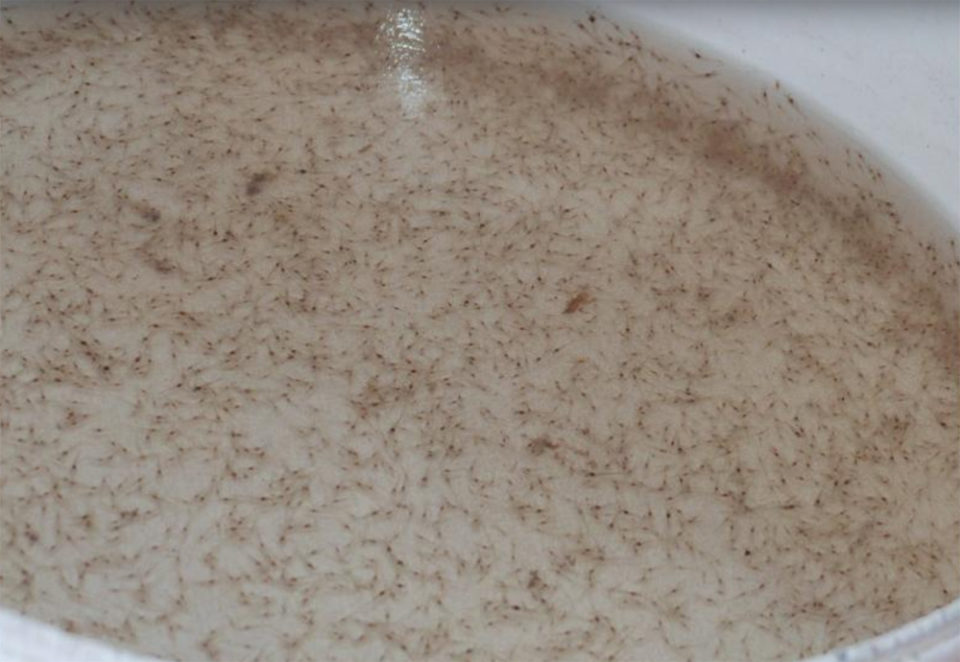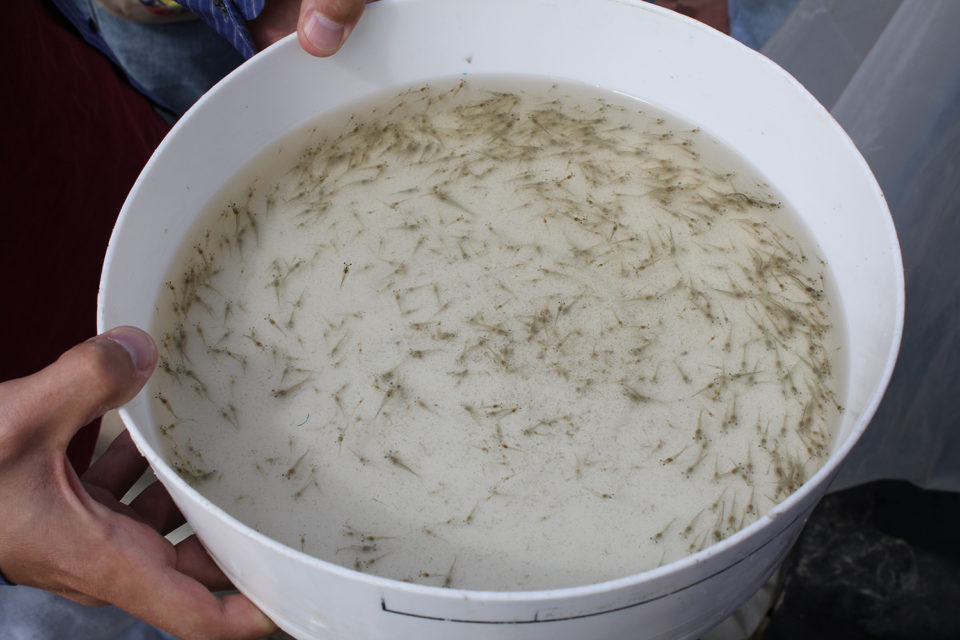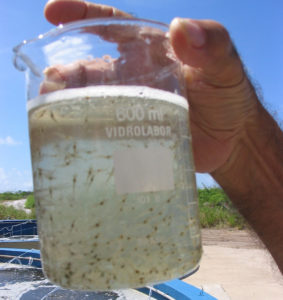Study evaluates molting stage, age to improve protocols to determine PL quality

With the development of the shrimp farming industry, there is a growing need for postlarvae (PL) producers and buyers to better guarantee PL quality, reflected in their overall production performance. Shrimp larval and postlarval survival depend on parent condition and nutritional status, maintenance and spawning conditions.
PL physiological status and quality is evaluated according to mobility, morphological development, branching level of the gills, presence of lipids in the hepatopancreas, amplitude of the sixth tail segment in relation to the length of the intestine, color, appearance, activity, size distribution, duration of larval stages and stress tests, among other characteristics.
The Pacific white shrimp (Litopenaeus vannamei) is an euryhaline species that tolerates a wide range of salinities (5 to 45 ppt); however, its isosmotic point is 27.7 ppt. But the range of salinity tolerance and the optimal salinity conditions may vary during development. The survival of shrimp PLs to salinity stress tests is mainly due to its osmoregulatory capacity, which depends on the PLs’ degree of development, age, molting stage and physiological condition.
Stress tests evaluate PL condition and are widely used as a quality control criterion in hatcheries and research laboratories. The most commonly used stress test involves subjecting PLs to low salinity, with an abrupt decrease in salinity for a certain time, allowing the subsequent recovery of the animals.
The molting cycle affects certain aspects of the biology of crustaceans, including animal morphology, and its cell metabolism, physiology and behavior. Penaeid shrimp molt at intervals of a few days or weeks, and the molt cycle is broadly divided into the stages of post-molt, intermolt, pre-molt and ecdysis. Each molting process experienced by the PL involves morphological and physiological changes, which become more complex as the animal develops.
The knowledge and ability to determine the stages of the molting cycle in cultured shrimp populations is an important management tool for the transfer of PLs from hatcheries to shrimp farms. Most evaluation criteria are visual, such as swimming behavior, and it is important to have a reliable and easy method to evaluate PL quality in the hatchery. We carried out this study to evaluate the relationship between the molting stage, age and osmotic stress in L. vannamei PLs to improve the use of stress tests. This article is adapted and summarized from Aquacultura (Ecuador) November 2017.
Experimental setup
The experiment was carried out at the marine shrimp nursery (LCM) of the Federal University of Santa Catarina, Brazil, using L. vannamei PL7 to PL17 from their internal production. A completely randomized design was applied with a 3 x 11 sampling and factorial arrangement for 33 treatments with three repetitions each, where factor 1 (F1) was the molting stage (intermolt, IM; initial premolt, PrMI; and final premolt, PrMF) and factor 2 (F2) was the age of PL (PL7 to PL17).
We worked with a total of 3,300 PLs, randomly mixed in the production lot used, and subjecting them to an osmotic stress test in each of the established molting periods. For this test, 330 PLs were used to identify branchial development and 660 PL to determine the molting stages. The PLs were analyzed with a binocular optical microscope to observe the morphology of the uropods and to classify the molting stages according to published technical literature.
PL samples were collected daily during the evaluation phase. From the collected samples, their general condition was determined in relation to the stage, molting period, branchial development, stress tests and dry weight determination. Similarly, PLs were determined to be free of diseases and with clean gills, and any PLs with necrosis or filamentous bacteria were discarded.
Subsequently, three samples of 10 PLs of each stage were collected, and the development of their branchial lobes and ramifications observed under a binocular optical microscope. The number of divisions of each branchial filament was counted and the branchial development index of the population was determined.
For the osmotic stress test, three samples of 100 PLs were collected from the production batch and maintained at 35 ppt salinity. The PLs were counted and placed in triplicate in 1-liter beakers with water of 0 ppt salinity, thus subjecting them to an abrupt change in salinity. The PLs were maintained under these conditions for 30 minutes, then returned to their initial salinity of 35 ppt for another 30 minutes. Then, the numbers of surviving PLs in each vessel expressed as a percentage of the initial number were counted and animals were discarded.
This experimental procedure was carried out for each age and for each of the molting stages defined. For the statistical analysis of the data, a random number generator was used to randomize the distribution of the treatments. For more detailed procedures on the experimental setup and procedures, as well as the statistical analyses used, please refer to the original publication.

Results and discussion
Water quality parameters (temperature, dissolved oxygen, salinity, pH and transparency) measured daily during the study period were within the recommended values for the culture of marine shrimp. The survivals obtained in the osmotic stress test were higher in the intermolt stage (74.12 percent).
The mean weights of PL vary depending on culture densities, broodstock source, water quality and feed provided. In our study, the PLs had a growth rate of 41 percent during the study period, with an average dry initial weight of 0.18 ± 0.027 mg at PL7 and a final weight of 15.42 ± 0.267 mg for PL 17, indicating that the PLs were well fed and that this factor did not influence the resulting survivals.
Table 1 shows the branchial development of postlarvae evaluated as well as branchial filaments counts in each age. An initial development of four filaments for PL7 and 14 filaments for PL17 were observed. Likewise, the values of the individual branchial development index (DBI) were determined with an initial value of 0.50 for PL7 and 0.88 for PL11, and the population development index (DBP) with 0.017 for PL7 and 0.029 for PL11. From PL12 onwards, these indexes were not calculated because the number of branches become too numerous.
Burbano, osmotic stress, Table 1
| Age | No. of filaments | RF | DBI | DBP |
|---|
Age | No. of filaments | RF | DBI | DBP |
|---|---|---|---|---|
| PL7 | 4 | 2 | 0.50 | 0.017 |
| PL8 | 5 | 2 | 0.40 | 0.013 |
| PL9 | 6 | 4 | 0.67 | 0.022 |
| PL10 | 7 | 6 | 0.86 | 0.029 |
| PL11 | 8 | 7 | 0.88 | 0.029 |
| PL12 | 9 | Highly branched | – | – |
| PL13 | 10 | Highly branched | – | – |
| PL14 | 11 | Highly branched | – | |
| PL15 | 12 | Highly branched | – | – |
| PL16 | 13 | Highly branched | – | – |
Table 2 shows PL survival in each of the ages evaluated with comparisons between all pairs of treatments. There were significant differences between treatment groups (interaction between molt and age; P = 0.0028). Average survival in the intermolt stage was 74.12 percent, while in the initial premolt stage it was 60.24 percent, and only 46.73 percent in the final premolt stage. The premolt stages for ages from PL7 to PL17 had low survival values relative to those for the intermolt stage, which had the highest survival values (91-100 percent) for PL15 to PL17.
Burbano, osmotic stress, Table 2
| Source | Sum of Squares | GI | Mean squares | F | P |
|---|
Source | Sum of Squares | GI | Mean squares | F | P |
|---|---|---|---|---|---|
| Treatments | 19.5913 | 32 | 0.61223 | 64.06 | 0.0000* |
| A: Factor 1 | 2.4248 | 2 | 1.21242 | 126.86 | 0.0000* |
| B: Factor 2 | 16.6876 | 10 | 1.66876 | 174.60 | 0.0000* |
| AB Interactions | 0.4788 | 20 | 0.02394 | 2.51 | 0.0028* |
| Experimental error | 0.6308 | 66 | 0.00956 | – | – |
| Total | 20.2220 | 98 | – | – | – |
The molting cycle and the different salinity concentrations likely influence the shrimp’s absorption of nutrients, which is weaker in the initial premolt (PrMI) and final premolt (PrMF) phases because there are alterations in the amino acid metabolism, in the apparent digestibility of carbohydrates and lipids in feed, in the osmotic capacity, hemocyanin, glucose, glycogen in the hepatopancreas, and osmotic capacity and total protein.
In the analysis for factor 2 (age), gill development determined that the older the age, the higher presence of branchial filaments. Likewise, the individual branchial development index (DBI) and the population branchial development index (DBP) were found to be directly proportional to PL age. Given the role of the gills in osmoregulation, at least part of the increase in survival may be due to further development.
Burbano, osmotic stress, Table 3
| Treatment | Molt Age | Mean % | Homogenous groups |
|---|
Treatment | Molt Age | Mean % | Homogenous groups |
|---|---|---|---|
| 23 | PrMF-PL7 | 0.00 | X |
| 12 | PrMI-PL7 | 1.67 | XX |
| 24 | PrMF-PL8 | 4.67 | XX |
| 1 | IM-PL7 | 9.33 | XX |
| 25 | PrMF-PL9 | 12.00 | X |
| 13 | PrMI-PL8 | 12.00 | XX |
| 2 | IM-PL8 | 14.30 | XX |
| 14 | PrMI-PL9 | 15.00 | XX |
| 26 | PrMF-PL10 | 18.30 | XX |
| 15 | PrMI-PL10 | 38.00 | XX |
In relation to age, survival was higher at PL17 stage (98.44 percent). These results suggest that the tolerance to osmotic stress increases as the age of the larvae increases. However, it is not the only factor because the stages of the molting cycle are also influenced by survival.
The interaction between the two factors (molt stages, age) increased with increasing PL age, so we determined that the best treatments to perform these PL stress tests to demonstrate their quality should be carried out during the intermolt stage and at PL15-17.

Survival by PL to a stress test is considered good when the values are more than 75 percent. Values obtained from PL11 in IM, PL12 in PRMI and PL17 in PrMF resulted in the highest survival when they were analyzed under the effect of the age and molting stage interaction.
The osmoregulatory capacity of PL during its early stages is deficient because the structures that perform such function (gills) are not completely branched and their exchange area is not enough to compensate for an osmotic shock, or cannot yet perform an efficient ion exchange. Other studies have shown that factors such as the hyperglycemic hormone and the metabolic profiles of the hemolymph are modified depending on the different salinities the shrimp are subjected to, and can influence their development.
Perspectives
The results of our study can contribute to improve protocols used to determine the quality of L. vannamei PL sold by commercial hatcheries. Within the protocols to determine PL quality, molting stage must be considered because low survivals in stress tests do not necessarily mean an inadequate quality lot of PL.
We conclude that, given the interaction between age and molting cycle stage, that osmotic stress tests should be done only with at least PL12 at the intermolt stage and that were cultured at 35 ppt salinity and 29 degrees-C.
References available from the senior author.
Authors
-
Elizabeth Burbano-Gallardo
Departamento de Recursos Hidrobiológicos
Facultad de Ciencias Pecuarias
Universidad de Nariño
San Juan de Pasto, Nariño, Colombia -
Marco Antonio Imués-Figueroa
Departamento de Recursos Hidrobiológicos
Facultad de Ciencias Pecuarias, Universidad de Nariño
San Juan de Pasto, Nariño, Colombia -
Dr. Edgar Andrés Gonzalez-Legarda
Departamento de Recursos Hidrobiológicos
Facultad de Ciencias Pecuarias
Universidad de Nariño
San Juan de Pasto, Nariño, Colombia -
Luis Otavio Brito
Departamento de Assistência Técnica e Extensão Rural
Instituto Agronômico de Pernambuco
Recife, Pernambuco, Brasil -
Dr. Alfredo Olivera Galvez
Laboratório de Maricultura Sustentável
Departamento de Pesca e Aquicultura
Universidade Federal Rural de Pernambuco
Recife, Pernambuco, Brasil -
Luis Alejandro Vinatea Arana, Ph.D.
Laboratório de Camarões Marinhos
Departamento de Aquicultura
Universidade Federal de Santa Catarina
Florianópolis, Santa Catarina, Brasil
Tagged With
Related Posts

Health & Welfare
Acclimating shrimp postlarvae before pond stocking
Shrimp postlarvae acclimation before stocking into the various growout systems (ponds, raceways, tanks) is a critical – and often overlooked, sometimes taken for granted – step in the shrimp culture process. Various water quality parameters should be changed slowly so that the young shrimp have the time to gradually adapt to the new conditions.

Aquafeeds
Biofloc consumption by Pacific white shrimp postlarvae
The stable isotopes technique with δ13C and δ15N can be used to determine the relevance of different food sources to shrimp feeding during the pre-nursery phase of Litopenaeus vannamei culture. During this trial, different types of commercial feed, microalgae, Artemia sp. nauplii and bioflocs were used as food sources.

Health & Welfare
How good are your shrimp postlarvae?
Stocking the best quality shrimp postlarvae, healthy and free of pathogens, is a critical management step with significant effects on the production and profitability of a shrimp farm.

Health & Welfare
Building a better shrimp nursery, part 1
Shrimp nursery systems offer an important opportunity to increase profits. Properly designed and operated nurseries are highly biosecure facilities to grow postlarvae at very high densities.


